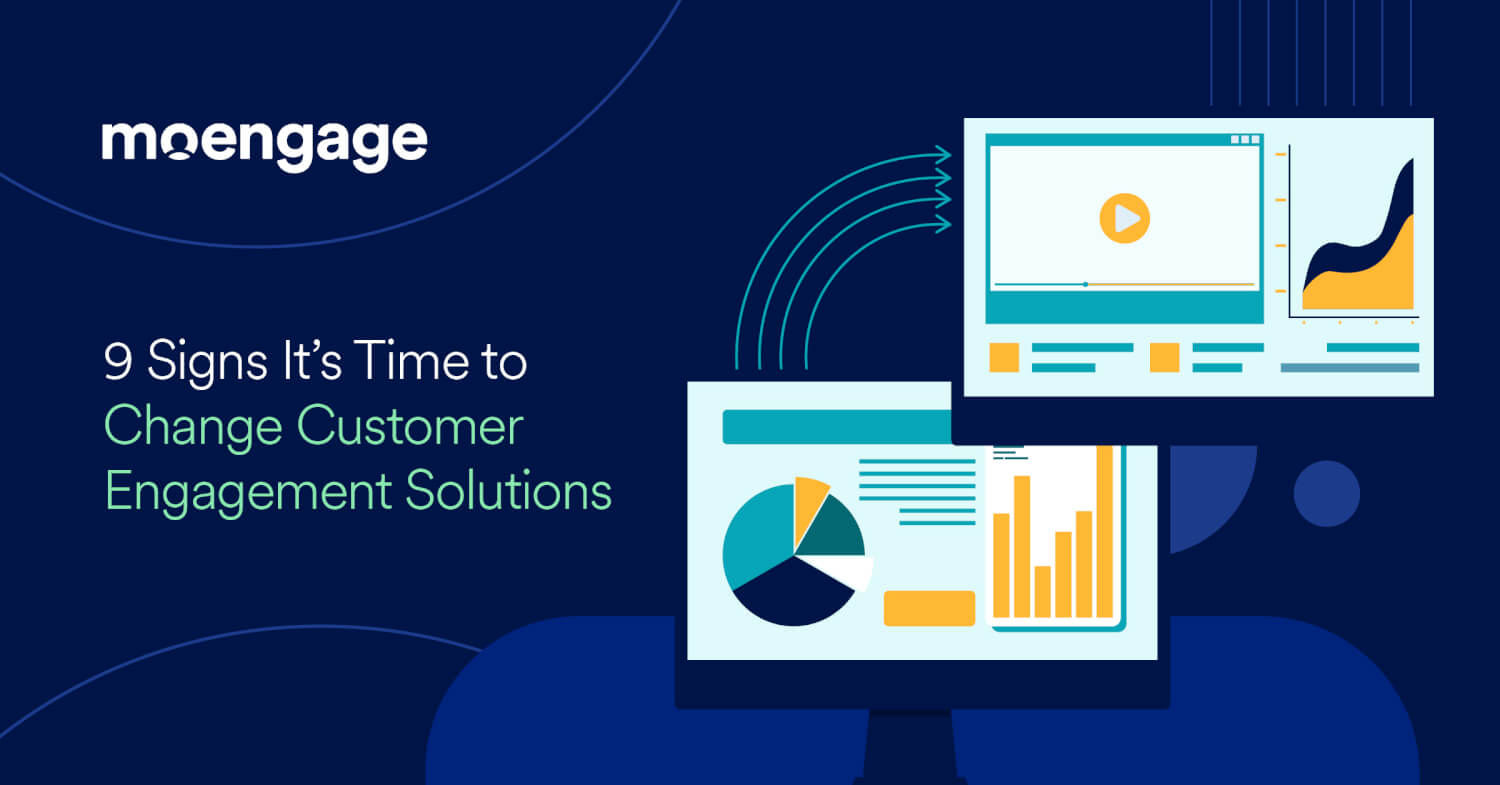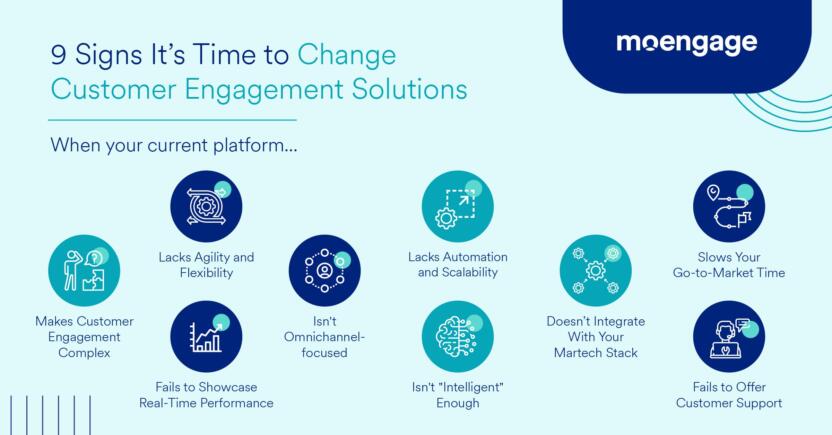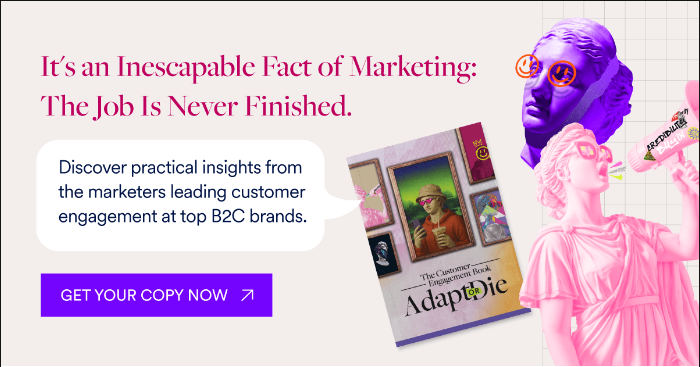9 Signs It’s Time to Change Customer Engagement Solutions

Reading Time: 9 minutes
Too often, marketers hold onto their Martech systems because they feel familiar. They get complacent, accept the problems they have with it, and find workarounds (that they think will be short-term but end up lasting for years). But the thing is, you don’t need to compromise with issues such as data silos, tech incompatibility, slow implementation, and go-to-market times.
Whatever red flags have led you to review your Customer Engagement Platform (CEP), it’s likely a sign that it needs an update.
To help you navigate this process, we examine some of the top signs that it’s time to change your customer engagement platform and provide you with evaluation criteria.
9 Signs It’s Time to Change Customer Engagement Solutions
When you use a platform for a long time, it can become difficult to envision your job without it. It can also feel like a major change isn’t worth it, as what you have ‘works’ for now. On top of that, it involves data migration, which can appear daunting (especially if you’re an enterprise brand possessing a wealth of customer data).

Regardless of these challenges, it’s important to maintain the quality of customer experience, as that will ultimately impact your revenue metrics.
Below, we examine nine signs that indicate it’s time to switch your customer engagement tools and technology.
1. When you need an agile and adaptable solution for digital transformation
In the current marketing landscape, most enterprise brands are in the midst of a necessary digital transformation that incorporates customer engagement into the foundation of the business. This process of integrating online and offline channels requires flexibility so that you can adapt to changing customer needs.
Unfortunately, many brands still rely on legacy systems that are rigid and limited in their scope, including integration limitations, lengthy implementation timelines, and limited capabilities. Due to this, even setting up a simple customer engagement campaign can be challenging. This dampens efforts to derive creative solutions for enhancing customer experiences.
On the other hand, an ideal customer engagement solution wouldn’t leave you — or your customers — feeling boxed in. Instead, it will empower you to develop personalized and seamless customer experiences that align with your engagement strategy. At the same time, it will enable your teams to act quickly and efficiently when deploying and optimizing customer engagement campaigns. If this is something that you want to achieve, it is high time you start evaluating alternatives.
2. When your current CEP doesn’t support your omnichannel goals
The reality is that most legacy systems aren’t designed to execute an omnichannel strategy effectively.
This is partly due to their integration shortcomings, and many of these systems are outdated and designed to specialize only around a single channel. Hence, such platforms often lack new-age channels like mobile push notifications and in-app messaging in their arsenal, which are critical for driving engagement. Simply put, they don’t meet the needs of modern omnichannel marketers looking to engage their customers across a range of touchpoints.
If the CEP you’re using doesn’t align with the omnichannel objectives you’re working towards and cannot maximize customer engagement, it’s time you made a switch.
3. When your current solution doesn’t have the automation capabilities to support your growing customer base
In today’s digital climate, it’s impossible to keep pace without using automation to eliminate routine tasks, reduce the chances of human errors, free up resources for other priorities, and optimize customer engagement campaigns in real-time.
However, many brands get stuck manually sorting their data, updating customer segments, or building customer journeys using platforms that lack sufficient automation capabilities. As a result, they outgrew their customer engagement platform earlier than expected, leading to many inefficiencies.
4. When your current solution constantly slows down your go-to-market time
Patience might be a virtue, but teams can’t afford to waste time in this fast-paced digital market. Trends — and customer attention — come and go rapidly. You’ll always be a step behind if you’re too slow to act.
According to B2C marketers polled in our State of Cross-Channel Marketing for 2024 report, 45.4% of marketers said they can’t react quickly enough to create timely, personalized cross-channel experiences, possibly because they aren’t using the right set of tools and technology.
To actively engage customers, you need to be able to create and implement campaigns quickly and test and optimize them to improve results in real-time. But to do that in practice, you can’t rely on outdated legacy tools.
Such platforms are often very clunky because they were put together through multiple acquisitions. This means you must navigate multiple products with multiple UIs and taxonomies, which can slow down your go-to-market time.
5. When your tech stack or customer engagement campaigns are becoming too complex
As your brand grows, you attract more diverse customers. With so many buyer personas to consider, managing all the campaigns you’re operating for your different segments, channels, and products can be extremely challenging. Eventually, getting clear insights into campaign performance can become extremely difficult.
One example is SoundCloud. After seven years of using their customer engagement platform, SoundCloud’s Martech stack had become overly complex. They had to create several internal APIs to handle engagement for their 100 million users. Additionally, they had to rely on a custom-built makeshift solution to aggregate customer data, as their provider was unable to do so. To address challenges with data quality, visibility, and customer support, they sought an alternate platform. After evaluating different options, SoundCloud switched to MoEngage to help manage their extensive data needs, seamlessly migrate live campaigns, and simplify their Martech stack.
Similarly, if the tech stack you’ve built over the years has become too complex or if you’re having difficulties managing multiple-point solutions that work asynchronously, it’s time to consider switching.
Remember, your CEP should enhance the capabilities of your Martech stack, not detract from it. This means simplifying your entire customer engagement operation, from campaign creation to implementation, and through to management and deriving insights. So, you need a CEP that is easy to use and provides you with consolidated data that powers deep, accurate, and actionable insights.
6. When your current CEP doesn’t integrate well with your Martech stack
Modern marketers rely on different tools and technology to meet the demands of their customers and keep them engaged. But even the best CEP loses value if you have to drop other apps, extensions, and solutions you use as part of your Martech stack.
It’s crucial that the CEP you choose integrates seamlessly with the marketing systems you’re already using (and tools you plan to use in the near future) without costing you must-have features and capabilities. Failing to integrate with valuable tools in your arsenal won’t just lead to missed opportunities; it can actually hinder your ability to manage campaigns and operate efficiently.
7. When you don’t have a clear understanding of how your customer engagement programs are performing
One of the most valuable features a CEP can offer is analytics, which takes your customer data and turns it into something discernible and actionable. If your platform isn’t offering clarity on channel effectiveness or other channel or customer insights, then the data you’re working so hard for will go largely unused. In that environment, how is your team meant to succeed?
Per our recent State of Cross-Channel Marketing 2024 report, 42.7% of marketers don’t know the long-term impacts of their campaigns, and 43.6% are struggling to identify gaps in their customer journey. But it doesn’t have to be this way.
No matter the industry you operate in, having a clear understanding of how customers act and behave on your platform is critical. Beyond that, you need powerful data visualizations and self-serve dashboards that allow your team to view this data meaningfully, so you can extract insights and make relevant improvements.
8. When your current platform lacks intuitive features and isn’t “intelligent” enough
Most legacy CEPs are developer-dependent, meaning you have to rely heavily on engineering support to set up campaigns, gain insights, and implement changes. This can significantly slow down campaign deployment and optimization. Instead, your team needs a self-serve CEP that’s both intuitive and intelligent.
An intuitive system will have a user-friendly UX that empowers your marketing team to make changes independently, quickly, and in real-time.
Similarly, an intelligent platform will give your team access to predictive and generative AI features that help you conduct dynamic A/B testing, predict conversions and churn, identify the optimal channels and delivery time/frequency, and create highly personalized content for your campaigns. And even better still, it allows you to do all this in real time, helping you raise the bar when it comes to providing a delightful experience for your customers.
9. When your current platform continuously fails to deliver great customer support
According to our conversation with Hope Barrett from SoundCloud and Scott Brinker from ChiefMartech, 26% of B2C marketers said product support was the top factor when choosing a replacement customer engagement solution.
Brands need more than just bells and whistles to connect with their customers; they also need to know how to use them properly to maximize engagement. Even more crucial is using various features efficiently to save time, resources, and costs.
You need effective onboarding support and product training to adapt to the new system and take advantage of all available features and capabilities. More importantly, the right CEP will have a team to regularly guide you on leveraging these features for your industry, objectives, and particular use cases.
How To Evaluate a Customer Engagement Solution: Top 5 Criteria to Look For
When choosing a CEP, it’s imperative to select a solution that will fit your needs, simplify processes for your team, and help you provide your customers with an engaging experience.
Below are some of the top criteria for evaluating a customer engagement solution.
1. An intuitive interface with AI capabilities
At its most basic essence, a customer engagement platform is meant to make business functions easier. If it isn’t intuitive for your team to use, its features will be underutilized and, ultimately, wasted.
B2C marketers need a CEP with a well-designed user interface and self-serve dashboards that make sense of their workflow. They also need a platform with AI capabilities, empowering them to do their jobs faster and more effectively.
MoEngage’s Sherpa AI takes the guesswork out of knowing when to send a message or what channel to use with its “Best Time to Send” and “Most Preferred Channel” features. Using predictive AI provides deeper insights, so campaigns can be optimized quickly for better results.
2. A repository to store, process, and orchestrate data for your analytics
To make data-driven decisions, you’ll need a customer engagement solution to effectively manage your data needs.
This means collecting, consolidating, and organizing all your data from online and offline sources to create a holistic, 360-degree view of your customers. With clean, intuitive data visualizations, B2C marketers can effectively (and quickly) extract insights and decide the right channel, frequency, or timing for their campaigns. This can be the difference between a well-crafted campaign that sticks and a sloppy, poorly executed campaign that fails to resonate with your customers.
MoEngage offers comprehensive omnichannel analytics through intuitive, self-serve data visualizations and custom reports that allow brands to orchestrate hyper-personalized journeys and campaigns that customers love.
3. Accurate attribution and deep segmentation capabilities that power actionable insights
To build customer-centric campaigns that drive engagement, you need actionable insights about the customer experiences and campaigns you create. This includes insights on last-touch attribution, i.e., where your customers are coming from, which channels or messaging pushed them to drop off or convert, etc.
Furthermore, a CEP must empower you to segment your customers using different methods, such as RFM segmentation. This allows you to group customers based on three core customer engagement factors: recency, frequency, and monetary value. Based on this, you can differentiate your engagement strategy and ensure it’s relevant to each customer group.
4. Seamless integration with your Martech stack
When striving for growth, brands can’t be held back by an overly complex web of systems that connect in some ways but not in others. The various features of your customer engagement solution and other tools in your arsenal should fit together neatly and securely so that your team can mix and match features as they develop their campaign strategies.
A system built with integration capability will reduce the load on IT support and open up opportunities to implement an omnichannel framework. This will help your team work independently and with agility.
That’s why MoEngage has a robust app marketplace that connects you to the best tools and services in the market for engaging customers at scale and automating your internal processes for efficiency.
5. An omnichannel-friendly interface
Modern shopping isn’t done strictly online or offline; it’s done everywhere, at all times. Whether you’re an e-commerce brand, a quick-service restaurant, a financial service company, or a media and entertainment company, you must provide omnichannel experiences to your customers to stand out and last. This will ensure
Any CEP you consider should be omnichannel in nature. This will empower you to connect with your customers across all potential and relevant touchpoints and ensure that your customers have a seamless and convenient experience regardless of how they interact with your brand.
Shift to a Reliable, Intuitive Customer Engagement Solution Like MoEngage
Familiarity isn’t an excuse to hold onto a system that doesn’t provide the right support. If you struggle to gain traction and ROI from your marketing campaigns, it may be time to switch your CEP.
Choosing a comprehensive omnichannel customer engagement platform with robust capabilities helps limit the integrations you’ll need and consolidates your customer engagement efforts. By bringing this all under one roof, you improve the quality of your data, the insights you draw from it, and the decisions you make about your customers’ experiences and marketing campaigns.
While migration is no easy decision for any brand, we’ve got some success stories from companies just like you that show we can be depended on to power your customer experiences and campaigns.
Schedule a demo today to find out how MoEngage can help you better connect with your customers with our suite of customer engagement products. We’ll also explain how simple, seamless, and quick it is to make the switch and prove why we’re worth switching to.


















